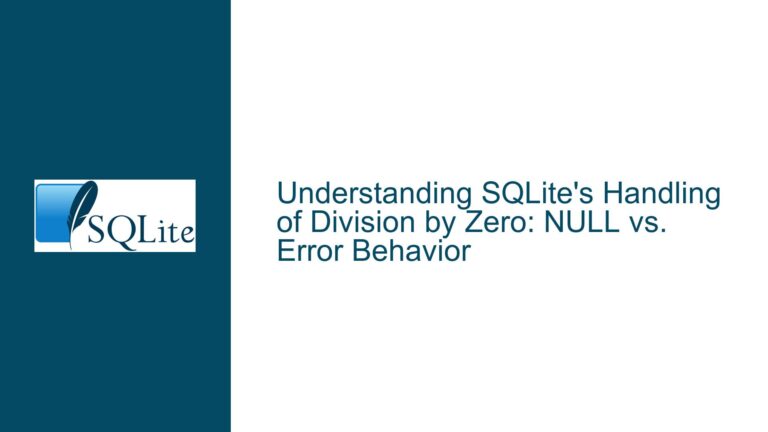SQLite Primary Key Constraint Violation with NULL Values
SQLite Primary Key Constraints and NULL Values Behavior
In SQLite, the behavior of primary key constraints when dealing with NULL values can be both surprising and counterintuitive, especially for developers accustomed to other relational database management systems (RDBMS). The primary key constraint is designed to enforce uniqueness and ensure that no two rows in a table have identical values in the primary key columns. However, SQLite’s handling of NULL values in primary key columns deviates from the standard behavior observed in many other databases.
When a table is created with a composite primary key (i.e., a primary key that spans multiple columns), SQLite allows NULL values to be inserted into any or all of the primary key columns without raising a constraint violation error. This behavior is documented in SQLite’s official documentation under the "quirks" section, but it remains a common source of confusion and bugs for developers who expect SQLite to enforce the same rules as other databases.
For example, consider a table tbl2 created with the following schema:
CREATE TABLE IF NOT EXISTS tbl2 (
name TEXT,
last_name TEXT,
PRIMARY KEY (name, last_name)
);
In this table, the combination of name and last_name columns forms a composite primary key. According to standard SQL, any attempt to insert a row where either name or last_name is NULL should result in a constraint violation. However, SQLite allows the following inserts without any errors:
INSERT INTO tbl2 VALUES('s', 'g'); -- Valid insert
INSERT INTO tbl2 VALUES('s', NULL); -- Also valid in SQLite
INSERT INTO tbl2 VALUES(NULL, NULL); -- Also valid in SQLite
The first insert is valid and expected, as both name and last_name have non-NULL values. However, the second and third inserts are problematic because they include NULL values in the primary key columns. In most other databases, these inserts would fail due to the primary key constraint. In SQLite, however, they succeed, leading to potential data integrity issues.
This behavior is rooted in SQLite’s implementation of the SQL standard, which treats NULL values as distinct from all other values, including other NULLs. Consequently, SQLite considers each row with a NULL in a primary key column to be unique, even if multiple rows have NULLs in the same columns. This design choice allows SQLite to maintain its lightweight and flexible nature but can lead to unexpected results if developers are not aware of this quirk.
NULL Values in Composite Primary Keys and Their Implications
The allowance of NULL values in composite primary keys in SQLite has several implications, both for database design and for application logic. Understanding these implications is crucial for developers who rely on SQLite for their applications.
First, the presence of NULL values in primary key columns can lead to data integrity issues. The primary key is intended to uniquely identify each row in a table, and allowing NULL values undermines this purpose. For example, consider the following sequence of inserts:
INSERT INTO tbl2 VALUES('s', NULL); -- First insert
INSERT INTO tbl2 VALUES('s', NULL); -- Second insert
In most databases, the second insert would fail because it violates the primary key constraint. However, in SQLite, both inserts succeed, resulting in two rows that are effectively indistinguishable based on their primary key values. This can lead to confusion and errors when querying or updating the table, as there is no clear way to differentiate between the rows.
Second, the behavior of NULL values in primary keys can affect the performance of queries. SQLite’s indexing mechanism relies on the uniqueness of primary key values to optimize query execution. When NULL values are present in primary key columns, the index may not function as efficiently, leading to slower query performance. This is particularly problematic in large tables where query performance is critical.
Third, the allowance of NULL values in primary keys can complicate data migration and integration with other systems. Many databases and applications assume that primary keys are non-NULL and unique. When migrating data from SQLite to another database, or when integrating SQLite with other systems, the presence of NULL values in primary keys can cause errors or require additional data cleansing steps.
Finally, the behavior of NULL values in primary keys can lead to subtle bugs in application logic. Developers may write code that assumes primary keys are always non-NULL, leading to unexpected behavior when NULL values are encountered. For example, consider the following pseudocode:
def update_user_name(user_id, new_name):
cursor.execute("UPDATE tbl2 SET name = ? WHERE name = ? AND last_name = ?", (new_name, user_id[0], user_id[1]))
If user_id contains NULL values, the update operation may not behave as expected, potentially leading to data corruption or loss.
Enforcing Non-NULL Constraints in Composite Primary Keys
To address the issues caused by NULL values in composite primary keys, developers can take several steps to enforce non-NULL constraints and ensure data integrity. These steps include modifying the table schema, using triggers, and implementing application-level checks.
Modifying the Table Schema
One approach to enforcing non-NULL constraints in composite primary keys is to modify the table schema to explicitly disallow NULL values in the primary key columns. This can be achieved by adding NOT NULL constraints to the columns:
CREATE TABLE IF NOT EXISTS tbl2 (
name TEXT NOT NULL,
last_name TEXT NOT NULL,
PRIMARY KEY (name, last_name)
);
With this schema, any attempt to insert NULL values into the name or last_name columns will result in a constraint violation:
INSERT INTO tbl2 VALUES('s', NULL); -- Fails with constraint violation
INSERT INTO tbl2 VALUES(NULL, NULL); -- Fails with constraint violation
This approach ensures that the primary key columns always contain non-NULL values, preserving the integrity of the primary key constraint.
Using Triggers to Enforce Constraints
Another approach to enforcing non-NULL constraints in composite primary keys is to use triggers. Triggers can be defined to check the values being inserted or updated in the table and raise an error if NULL values are detected in the primary key columns:
CREATE TRIGGER enforce_non_null_primary_key
BEFORE INSERT ON tbl2
FOR EACH ROW
BEGIN
SELECT RAISE(ABORT, 'NULL values not allowed in primary key columns')
WHERE NEW.name IS NULL OR NEW.last_name IS NULL;
END;
This trigger will prevent any insert or update operation that attempts to set NULL values in the name or last_name columns:
INSERT INTO tbl2 VALUES('s', NULL); -- Fails due to trigger
INSERT INTO tbl2 VALUES(NULL, NULL); -- Fails due to trigger
Triggers provide a flexible way to enforce complex constraints and can be particularly useful when modifying the table schema is not feasible.
Implementing Application-Level Checks
In addition to modifying the table schema and using triggers, developers can implement application-level checks to ensure that NULL values are not inserted into primary key columns. This approach involves validating the data before executing insert or update operations:
def insert_user(name, last_name):
if name is None or last_name is None:
raise ValueError("NULL values not allowed in primary key columns")
cursor.execute("INSERT INTO tbl2 VALUES (?, ?)", (name, last_name))
Application-level checks provide an additional layer of protection and can be customized to meet the specific needs of the application. However, they rely on the application code to enforce the constraints, which may not be as reliable as database-level constraints.
Combining Approaches for Robustness
For maximum robustness, developers can combine multiple approaches to enforce non-NULL constraints in composite primary keys. For example, a table schema with NOT NULL constraints can be complemented with triggers and application-level checks to ensure that NULL values are never inserted into the primary key columns:
CREATE TABLE IF NOT EXISTS tbl2 (
name TEXT NOT NULL,
last_name TEXT NOT NULL,
PRIMARY KEY (name, last_name)
);
CREATE TRIGGER enforce_non_null_primary_key
BEFORE INSERT ON tbl2
FOR EACH ROW
BEGIN
SELECT RAISE(ABORT, 'NULL values not allowed in primary key columns')
WHERE NEW.name IS NULL OR NEW.last_name IS NULL;
END;
def insert_user(name, last_name):
if name is None or last_name is None:
raise ValueError("NULL values not allowed in primary key columns")
cursor.execute("INSERT INTO tbl2 VALUES (?, ?)", (name, last_name))
By combining these approaches, developers can ensure that NULL values are never inserted into the primary key columns, preserving the integrity of the primary key constraint and avoiding the issues caused by SQLite’s handling of NULL values in composite primary keys.
Conclusion
SQLite’s handling of NULL values in composite primary keys is a well-documented quirk that can lead to data integrity issues, performance degradation, and application bugs if not properly addressed. By understanding the implications of this behavior and taking steps to enforce non-NULL constraints, developers can ensure that their SQLite databases remain robust and reliable. Whether through schema modifications, triggers, application-level checks, or a combination of these approaches, it is essential to prevent NULL values from undermining the integrity of primary key constraints.





